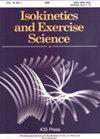The effects of blood flow restriction resistance training on indices of delayed onset muscle soreness and peak power
IF 0.7
4区 医学
Q4 ENGINEERING, BIOMEDICAL
引用次数: 1
Abstract
BACKGROUND: Low-load resistance training with blood flow restriction (LL + BFR) attenuated delayed onset muscle soreness (DOMS) under some conditions. OBJECTIVE: The purpose of this study examined the effects of reciprocal concentric-only elbow flexion-extension muscle actions at 30% of peak torque on indices of DOMS. METHODS: Thirty untrained women (mean ± SD; 22 ± 2.4 years) were randomly assigned to 6 training days of LL + BFR (n= 10), low-load non-BFR (LL) (n= 10), or control (n= 10). Participants completed 4 sets (1 × 30, 3 × 15) of submaximal (30% of peak torque), unilateral, isokinetic (120∘s-1) muscle actions. Indices of DOMS including peak power, resting elbow joint angle (ROM), perceived muscle soreness (VAS), and pain pressure threshold (PPT) were assessed. RESULTS: There were no changes in peak power, ROM, or VAS. There was a significant interaction for PPT. Follow-up analyses indicated PPT increased for the LL + BFR condition (Day 5 > Day 2), but did not decrease below baseline. The results of the present study indicated LL + BFR and LL did not induce DOMS for the elbow extensors in previously untrained women. CONCLUSION: These findings suggested LL + BFR and LL concentric-only resistance training could be an effective training modality to elicit muscular adaptation without inducing DOMS.血流限制阻力训练对迟发性肌肉酸痛指标和峰值功率的影响
背景:血流量限制低负荷阻力训练(LL+BFR)在一定条件下可减轻延迟性肌肉酸痛(DOMS)。目的:本研究的目的是检查在峰值扭矩的30%下,仅肘关节屈伸肌的往复同心动作对DOMS指标的影响。方法:30名未经训练的女性(平均值±SD;22±2.4岁)被随机分配到6天的LL+BFR训练(n=10)、低负荷非BFR(LL)训练(n=10)或对照组(n=0)。参与者完成了4组(1×30,3×15)次最大(峰值扭矩的30%)、单侧等速(120∘s-1)肌肉动作。评估DOMS的指标,包括峰值功率、静息肘关节角度(ROM)、感知肌肉酸痛(VAS)和疼痛压力阈值(PPT)。结果:峰值功率、ROM或VAS均无变化。有一个重要的互动PPT。随访分析表明,LL+BFR条件下PPT增加(第5天>第2天),但在基线以下没有减少。本研究的结果表明,LL+BFR和LL在以前未经训练的女性中不会诱发肘伸肌的DOMS。结论:LL+BFR和LL同心阻力训练是一种有效的训练方式,可以在不诱导DOMS的情况下引发肌肉适应。
本文章由计算机程序翻译,如有差异,请以英文原文为准。
求助全文
约1分钟内获得全文
求助全文
来源期刊

Isokinetics and Exercise Science
医学-工程:生物医学
CiteScore
1.20
自引率
14.30%
发文量
37
审稿时长
>12 weeks
期刊介绍:
Isokinetics and Exercise Science (IES) is an international journal devoted to the study of theoretical and applied aspects of human muscle performance. Since isokinetic dynamometry constitutes the major tool in this area, the journal takes a particular interest in exploring the considerable potential of this technology.
IES publishes studies associated with the methodology of muscle performance especially with respect to the issues of reproducibility and validity of testing, description of normal and pathological mechanical parameters which are derivable from muscle testing, applications in basic research topics such as motor learning paradigms and electromyography. The journal also publishes studies on applications in clinical settings and technical aspects of the various measurement systems employed in human muscle performance research.
The journal welcomes submissions in the form of research papers, reviews, case studies and technical reports from professionals in the fields of sports medicine, orthopaedic and neurological rehabilitation and exercise physiology.
 求助内容:
求助内容: 应助结果提醒方式:
应助结果提醒方式:


